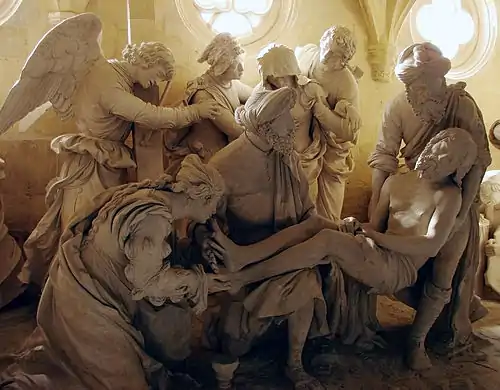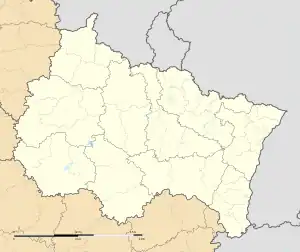Saint-Mihiel
Saint-Mihiel (French pronunciation: [sɛ̃ mijɛl]) is a commune in the Meuse department in Grand Est in north-eastern France.[3]
Saint-Mihiel | |
|---|---|
 Entombment of Christ, sculpture by Ligier Richier, in the Church of St. Étienne, in Saint-Mihiel | |
.svg.png.webp) Coat of arms | |
Location of Saint-Mihiel | |
 Saint-Mihiel  Saint-Mihiel | |
| Coordinates: 48°53′21″N 5°32′37″E | |
| Country | France |
| Region | Grand Est |
| Department | Meuse |
| Arrondissement | Commercy |
| Canton | Saint-Mihiel |
| Intercommunality | Sammiellois |
| Government | |
| • Mayor (2020–2026) | Xavier Cochet[1] |
| Area 1 | 33 km2 (13 sq mi) |
| Population | 4,000 |
| • Density | 120/km2 (310/sq mi) |
| Time zone | UTC+01:00 (CET) |
| • Summer (DST) | UTC+02:00 (CEST) |
| INSEE/Postal code | 55463 /55300 |
| 1 French Land Register data, which excludes lakes, ponds, glaciers > 1 km2 (0.386 sq mi or 247 acres) and river estuaries. | |
Geography
Saint-Mihiel lies on the banks of the river Meuse.
History
A Benedictine abbey was established here in 708 or 709 by Count Wulfoalde and his wife Adalsinde. The library, containing over 9,000 works, is still on the original site.
During World War I, Saint-Mihiel was captured by the Germans in 1914, and was recaptured during the Battle of Saint-Mihiel by the American Expeditionary Forces (AEF) from 12 September to 19 September 1918.
Population
| Year | Pop. | ±% p.a. |
|---|---|---|
| 1968 | 5,295 | — |
| 1975 | 5,572 | +0.73% |
| 1982 | 5,525 | −0.12% |
| 1990 | 5,367 | −0.36% |
| 1999 | 5,260 | −0.22% |
| 2007 | 4,816 | −1.10% |
| 2012 | 4,339 | −2.06% |
| 2017 | 4,112 | −1.07% |
| Source: INSEE[4] | ||
Features
Saint-Mihiel is known for its sculptures by Renaissance sculptor Ligier Richier (1500–1567).
Saint-Mihiel serves both as the starting and ending point of the 2014 video game Valiant Hearts: The Great War.
See also
References
- "Répertoire national des élus: les maires" (in French). data.gouv.fr, Plateforme ouverte des données publiques françaises. 13 September 2022.
- "Populations légales 2020". The National Institute of Statistics and Economic Studies. 29 December 2022.
- INSEE commune file
- Population en historique depuis 1968, INSEE